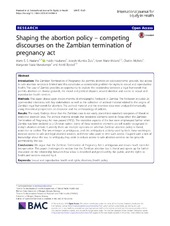| dc.contributor.author | Haaland, Marte Emilie Sandvik | en_US |
| dc.contributor.author | Haukanes, Haldis | en_US |
| dc.contributor.author | Zulu, Joseph M. | en_US |
| dc.contributor.author | Moland, Karen Marie | en_US |
| dc.contributor.author | Michelo, Charles Cheembo | en_US |
| dc.contributor.author | Munakampe, Margarate Nzala | en_US |
| dc.contributor.author | Blystad, Astrid | en_US |
| dc.date.accessioned | 2019-05-31T12:43:17Z | |
| dc.date.available | 2019-05-31T12:43:17Z | |
| dc.date.issued | 2019-01-28 | |
| dc.Published | Haaland MES, Haukanes H, Zulu JM, Moland KM, Michelo CC, Munakampe, Blystad A. Shaping the abortion policy – competing discourses on the Zambian termination of pregnancy act. International Journal for Equity in Health. 2019;18:20 | eng |
| dc.identifier.issn | 1475-9276 | |
| dc.identifier.uri | https://hdl.handle.net/1956/19835 | |
| dc.description.abstract | Introduction: The Zambian Termination of Pregnancy Act permits abortion on socio-economic grounds, but access to safe abortion services is limited and this constitutes a considerable problem for rights to sexual and reproductive health. The case of Zambia provides an opportunity to explore the relationship between a legal framework that permits abortion on diverse grounds, the moral and political disputes around abortion and access to sexual and reproductive health services. Methods: This paper draws upon eleven months of ethnographic fieldwork in Zambia. The fieldwork included 28 open-ended interviews with key stakeholders as well as the collection of archival material related to the origins of Zambia’s legal framework for abortion. The archival material and the interview data were analyzed thematically, using theoretical perspectives on discourse and the anthropology of policies. Results: The study findings show that the Zambian case is not easily placed into standard categories of liberal or restrictive abortion laws. The archival material reveals that restrictive elements were in focus when the Zambian Termination of Pregnancy Act was passed (1972). The restrictive aspects of the law were emphasized further when Zambia was later declared as a Christian nation. Some of these restrictive elements are still readily recognized in today’s abortion debate. Currently there are multiple opinions on whether Zambian abortion policy is liberal, restrictive or neither. The law emerges as ambiguous, and this ambiguity is actively used by both those working to increase access to safe and legal abortion services, and those who work to limit such access. Coupled with a lack of knowledge about the law, its ambiguity may work to reduce access to safe abortion services on the grounds permitted by the law. Conclusions: We argue that the Zambian Termination of Pregnancy Act is ambiguous and leaves much room for interpretation. This paper challenges the notion that the Zambian abortion law is liberal and opens up for further discussion on the relationship between how a law is described and perceived by the public, and the rights to health and services ensured by it. | en_US |
| dc.language.iso | eng | eng |
| dc.publisher | BioMed Central | eng |
| dc.rights | Attribution CC BY | eng |
| dc.rights.uri | http://creativecommons.org/licenses/by/4.0 | eng |
| dc.subject | Sexual and reproductive health and rights | eng |
| dc.subject | Abortion | eng |
| dc.subject | Health policy | eng |
| dc.title | Shaping the abortion policy – competing discourses on the Zambian termination of pregnancy act | en_US |
| dc.type | Peer reviewed | |
| dc.type | Journal article | |
| dc.date.updated | 2019-01-28T14:52:33Z | |
| dc.description.version | publishedVersion | en_US |
| dc.rights.holder | Copyright 2019 The Author(s) | |
| dc.identifier.doi | https://doi.org/10.1186/s12939-018-0908-8 | |
| dc.identifier.cristin | 1666735 | |
| dc.source.journal | International Journal for Equity in Health | |
| dc.identifier.citation | International Journal for Equity in Health. 2019, 18, 20. | |

